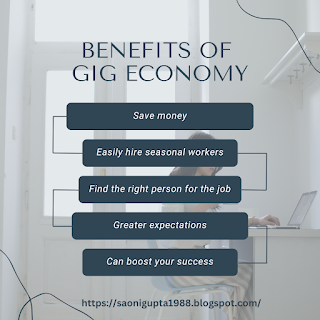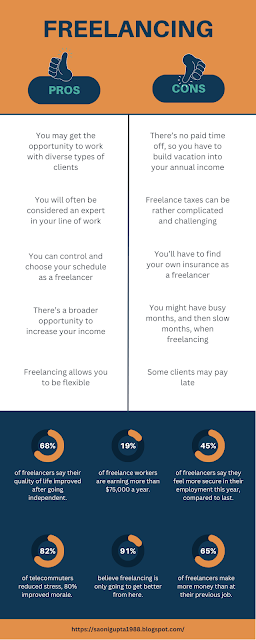Gig Economy and Freelancing: Flexible Employment
The gig economy and freelancing have become increasingly popular and rapidly transformed the labor market in recent years. With the rise of technology and online platforms, more and more workers are embracing non-traditional work arrangements and finding new opportunities to showcase their skills and expertise. In this blog, I will explore the rise of the gig economy and freelancing, including its impact on the labor market, economy, and society.
The Gig Economy and Freelancing: Definition and Characteristics
The gig economy and freelancing are two terms that are often used interchangeably, but they are not exactly the same thing. The gig economy, also known as the on-demand economy, is a term used to describe a labor market that is characterized by the prevalence of short-term contracts or freelance work rather than permanent jobs.
Gig workers, also referred to as independent contractors or freelancers, typically work on a project-by-project basis rather than being employed full-time by a single employer. Examples of gig economy platforms include Uber, Lyft, TaskRabbit, and Upwork. Freelancing, on the other hand, refers specifically to self-employment in which individuals offer their skills or services to clients on a project-by-project basis.
Both the gig economy and freelancing share some common characteristics. First, they offer workers a greater degree of flexibility and autonomy compared to traditional full-time jobs. Workers in the gig economy and freelancers have the freedom to choose when and where they work, as well as to set their own rates and clients.
Second, these types of work arrangements are often facilitated by digital platforms and technology. Freelancers and gig workers can find work through online marketplaces or job boards, and use digital tools to communicate with clients and manage projects.
Finally, the gig economy and freelancing are often associated with a higher degree of risk and uncertainty compared to traditional jobs. Workers in these arrangements are self-employed and may not have access to benefits such as health insurance or paid time off.
Despite these commonalities, there are some important differences between the gig economy and freelancing. In the gig economy, workers typically perform specific tasks or services for a client, whereas freelancers may offer a broader range of skills and services. Additionally, workers in the gig economy may work for multiple clients simultaneously, whereas freelancers often work on a project-by-project basis for a single client.
Overall, the gig economy and freelancing are both part of a larger trend towards more flexible and autonomous work arrangements. While they offer workers greater freedom and flexibility, they also come with some challenges and risks that workers need to be aware of and take steps to manage them effectively.
The Growth of the Gig Economy and Freelancing
According to a report by the McKinsey Global Institute, 20-30% of the workforce in the United States and the European Union is engaged in some form of independent work. This figure is projected to increase even more in the future. The rise of the gig economy and freelancing can be attributed to several factors, including advances in technology, changing attitudes towards work, and a desire for more flexibility and autonomy in work arrangements.
Advances in Technology
One of the main drivers of the gig economy and freelancing is the rise of digital platforms and technology. The internet has made it easier than ever for workers to find and connect with clients and for clients to find and hire workers with the specific skills they need. Online marketplaces like Upwork, Fiverr, and Freelancer have made it possible for freelancers to find work all around the world, while ride-sharing apps like Uber and Lyft have made it possible for anyone with a car to earn money as a driver.
In addition to online marketplaces and apps, advances in digital tools and communication technologies have made it easier for freelancers and gig workers to manage projects, communicate with clients, and collaborate with other workers. Cloud-based project management tools like Trello and Asana, video conferencing platforms like Zoom and Skype, and online payment systems like PayPal and Stripe have all made it easier for workers to work remotely and manage projects from anywhere.
Changing Attitudes towards Work
Another factor driving the rise of the gig economy and freelancing is changing attitudes towards work. Many workers today are seeking more flexibility and autonomy in their work arrangements and are less interested in traditional full-time jobs that offer less control over their schedules and less opportunity for creative expression. This is particularly true among younger generations, who place a high value on work-life balance and personal fulfillment.
At the same time, many companies are becoming more open to hiring freelancers and gig workers, as it allows them to tap into a broader pool of talent and expertise without being committed for full-time wages and benefits. This is particularly true in industries like technology, marketing, and creative services, where workers with specialized skills are in high demand.
Desire for Flexibility and Autonomy
Finally, the rise of the gig economy and freelancing can be attributed to a desire for more flexibility and autonomy in work arrangements. Workers in these arrangements can choose when and where they work and can often set their own rates and choose their own clients. This allows them to fit work around other commitments, like family or hobbies, and to have more control over their own schedules.
For many workers, the gig economy and freelancing offer the opportunity to pursue their passions and interests while still earning a living. This can be particularly appealing for workers in creative or artistic fields, who may have struggled to find traditional full-time jobs that allow them to express themselves fully.
Impact of the Gig Economy and Freelancing on the Labor Market
The gig economy and freelancing have had a significant impact on the labor market, both positive and negative. Here are some of the key ways in which these trends have affected the job market:
Positive Impacts
More Flexibility: Workers in the gig economy and freelancers enjoy greater flexibility in their work schedules and locations. This can be especially beneficial for people with other commitments, such as caregiving responsibilities, or for those who prefer a non-traditional work style.
Increased Opportunities: The gig economy and freelancing have created new opportunities for people to work in fields that may have been previously closed to them. Workers can offer their services online and attract clients from around the world, which can lead to increased job opportunities and earnings potential.
Lower Entry Barriers: Workers in the gig economy and freelancers can start working without the need for significant capital or infrastructure. All that is required is a computer or a car, depending on the type of work being done. This makes it easier for people to start their own businesses and pursue their own interests.
Improved Work-Life Balance: The gig economy and freelancing can provide workers with greater control over their schedules and the ability to work from anywhere. This can lead to improved work-life balance, which can be especially important for workers with families or other commitments.
Negative Impacts
Income Insecurity: The gig economy and freelancing can be unstable, with income often fluctuating and benefits like health insurance and retirement savings often not available. This can create income insecurity for workers, making it difficult to plan for the future.
Lack of Benefits: Most gig workers and freelancers are classified as independent contractors, which means they are not eligible for employee benefits like health insurance, retirement savings, or paid time off. This can make it difficult for workers to afford health care or to take time off when they need to.
Lack of Protection: Independent contractors are not protected by labor laws in the same way as traditional employees. This can leave workers vulnerable to exploitation, including low wages, poor working conditions, and discrimination.
Reduced Job Security: Traditional full-time jobs often provide more job security, with benefits like severance pay and unemployment insurance available if a worker is laid off. In the gig economy and freelancing, however, workers have less protection and may find it harder to make ends meet if they lose a client or job.
Impact of the Gig Economy and Freelancing on the Economy
The rise of the gig economy and freelancing has had a vital impact on the economy as a whole. Here are some of the key ways in which these trends have affected the economy:
Positive Impacts
Increased Economic Activity: The gig economy and freelancing have contributed to increased economic activity, as more people are able to start their own businesses and offer their services to clients around the world. This can lead to increased spending and job creation, which can be beneficial for the overall economy.
Greater Innovation: The gig economy and freelancing have fostered greater innovation, as workers are able to pursue their own interests and develop new products and services. This can lead to the creation of new industries and the development of new technologies, which can have a positive impact on the economy.
Reduced Costs: The gig economy and freelancing have enabled businesses to reduce costs by outsourcing work to freelancers and independent contractors, rather than hiring full-time employees. This can lead to lower labor costs and greater efficiency, which can be beneficial for businesses and the economy as a whole.
Negative Impacts
Increased Competition: The gig economy and freelancing have created more competition in many industries as workers from around the world are able to offer their services online. This can lead to lower prices for consumers, but it can also create challenges for businesses that are not able to compete on price or quality.
Reduced Tax Revenue: The gig economy and freelancing have created challenges for governments, as workers often do not pay the same level of taxes as traditional employees. This can lead to reduced tax revenue, which can make it more difficult for governments to provide essential services and invest in infrastructure.
Impact of the Gig Economy and Freelancing on Society
The rise of the gig economy and freelancing has had an important impact on society as a whole. Here are some of the key ways in which these trends have affected society:
Positive Impacts
Increased Flexibility: The gig economy and freelancing have provided workers with greater flexibility, allowing them to choose their own hours and work from wherever they choose. This can be especially beneficial for individuals who need to balance work with other responsibilities, such as caregiving or education.
Greater Job Opportunities: The gig economy and freelancing have created new job opportunities for individuals who may not have had access to traditional employment, such as individuals with disabilities or those living in remote areas. This can help reduce unemployment and increase economic participation.
Improved Work-Life Balance: The gig economy and freelancing have made it possible for people to better balance their work and personal lives by allowing them to work from home or on their own schedule. This can help to reduce stress and improve overall quality of life.
Negative Impacts
Increased Income Inequality: The gig economy and freelancing have contributed to income inequality, as some workers may earn significantly more or less than others, depending on factors such as experience, location, and industry. This can exacerbate existing economic disparities and create challenges for social mobility.
Reduced Job Security: The gig economy and freelancing have also reduced job security for many workers, as they may not have access to the same benefits and protections as traditional employees. This can create financial instability and make it more difficult for individuals to plan for the future.
Summary
In conclusion, the gig economy and freelancing have created new opportunities for workers and businesses alike, providing greater flexibility, lower entry barriers, and increased job opportunities. However, they have also created challenges such as income insecurity, lack of benefits, and reduced job security.
As these trends continue to grow, it is essential for policymakers, businesses, and workers themselves to adapt to this changing landscape. Governments must ensure that labor laws and protections are updated to reflect the realities of the gig economy and freelancing, and businesses must find new ways to provide benefits and support to their workers.
Workers themselves must also be aware of the challenges and opportunities presented by the gig economy and freelancing, and seek out opportunities that best suit their needs and goals. By embracing these trends while also addressing their challenges, the gig economy and freelancing can continue to be a driving force for innovation and growth in the labor market.







Very nice 👍
ReplyDeleteThank u so much !!! 💖
DeleteAbsolutely. Completely agree with ur views.
ReplyDeleteThank u so much !!! 😊
Delete